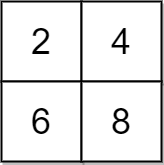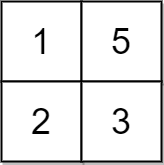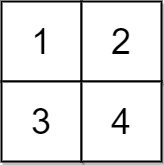LeetCode-in-Java
2033. Minimum Operations to Make a Uni-Value Grid
Medium
You are given a 2D integer grid of size m x n and an integer x. In one operation, you can add x to or subtract x from any element in the grid.
A uni-value grid is a grid where all the elements of it are equal.
Return the minimum number of operations to make the grid uni-value. If it is not possible, return -1.
Example 1:

Input: grid = [[2,4],[6,8]], x = 2
Output: 4
Explanation: We can make every element equal to 4 by doing the following:
-
Add x to 2 once.
-
Subtract x from 6 once.
-
Subtract x from 8 twice.
A total of 4 operations were used.
Example 2:

Input: grid = [[1,5],[2,3]], x = 1
Output: 5
Explanation: We can make every element equal to 3.
Example 3:

Input: grid = [[1,2],[3,4]], x = 2
Output: -1
Explanation: It is impossible to make every element equal.
Constraints:
m == grid.lengthn == grid[i].length1 <= m, n <= 1051 <= m * n <= 1051 <= x, grid[i][j] <= 104
Solution
import java.util.Arrays;
public class Solution {
public int minOperations(int[][] grid, int x) {
int[] arr = new int[grid.length * grid[0].length];
int k = 0;
for (int[] ints : grid) {
for (int j = 0; j < grid[0].length; j++) {
arr[k] = ints[j];
k++;
}
}
Arrays.sort(arr);
int target = arr[arr.length / 2];
int res = 0;
for (int i = 0; i < arr.length; i++) {
if (i < arr.length / 2) {
int rem = target - arr[i];
if (rem % x != 0) {
return -1;
}
res += rem / x;
} else {
int rem = arr[i] - target;
if (rem % x != 0) {
return -1;
}
res += rem / x;
}
}
return res;
}
}

